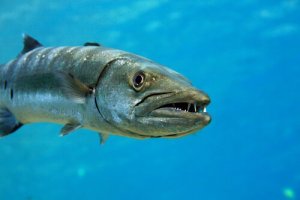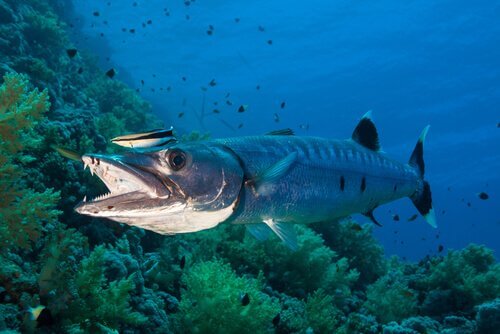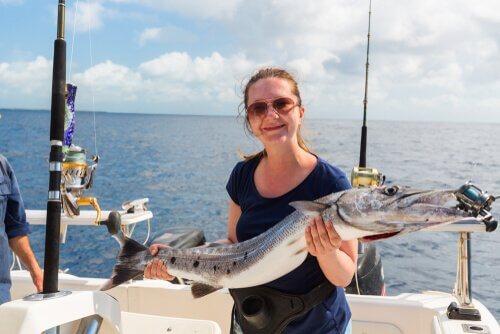The Barracuda: an Aggressive and Unpredictable Fish

When we think of dangerous marine animals, we usually think of sharks, killer whales and jellyfish. However, not much is known about one of the most common and aggressive fish in coastal waters: the barracuda.
Morphology and habitat of the barracuda
The barracuda can vary greatly in size; it can measure between 20 and 70 inches. It has a very aerodynamic shape that makes it tremendously fast and it stands out for its elongated and muscular body. This fish looks pretty harmless until you take a good look at its mouth.
His jaw is very large compared to the rest of its body. It houses a row of sharp, irregular teeth that will make you panic if you come face to face with them.
Its weight ranges between 20 and 45 pounds; however, it’s very possible to also find specimens that are almost 6.5 feet long and 55 pounds. Its strong jaw is capable of tearing its prey apart very violently. Few rivals are able to survive an adult barracuda attack.

As for its habitat, adults and younger specimens inhabit different places. Young barracudas tend to frequent shallow and coastal areas, where there are easy prey and warmer waters. On the other hand, adults spend most of their time in deeper waters.
You can also usually find them in mangrove areas or in coastal lagoons, always on the lookout for something to eat. You can find one of these predators in almost any part of the world. However, we highly recommend that you don’t bother them!
Diet
An adult barracuda can eat almost anything edible. Having said that, his favorite meals are small fish that are quick and easy to catch, small crustaceans, and squid.

Barracudas don’t include humans in their diets and it’s very uncommon for them to attack us if they don’t feel threatened. If they do make an explosive attack, they tend to flee very quickly after. The consequences of an adult barracuda attack are usually severe and include serious injuries. However, they often won’t result in death.
Reproduction
This fish usually breeds between the months of April and September, when the water is usually warmer and there is more food available. When they reach the age of three, a male barracuda is already developed enough for reproduction. Females, on the other hand, need another year for their body to be ready.
Females prefer to lay their eggs in areas with shallow and warm water. They lay them in protected areas, but they spread them out as much as possible so that other fish won’t eat them.
Each time a female lays her eggs, she will lay between 5000 and 30000 eggs. This is enough to guarantee a new generation of barracudas, since many of them won’t hatch and will instead be eaten by predators.
When they do hatch, reef areas offer small fish the protection they need before venturing out to explore deeper, more dangerous areas. In those deeper areas, they’re easy prey for predators to catch.
Is the barracuda edible?
Humans sometimes eat the medium-sized specimen in the form of fillets. The larger barracudas, however, have been known to cause food poisoning in eastern countries.

Because of its appearance, it’s one of the most valued sport-fishing fish. Its speed and strength make it a very difficult species to catch with a rod. However, if you can catch one, and get a picture of its incredible teeth, it’s very impressive.
Currently, it’s not at risk of extinction since they are quite abundant. This is great news given how much the ocean and its creatures are suffering in these times.
When we think of dangerous marine animals, we usually think of sharks, killer whales and jellyfish. However, not much is known about one of the most common and aggressive fish in coastal waters: the barracuda.
Morphology and habitat of the barracuda
The barracuda can vary greatly in size; it can measure between 20 and 70 inches. It has a very aerodynamic shape that makes it tremendously fast and it stands out for its elongated and muscular body. This fish looks pretty harmless until you take a good look at its mouth.
His jaw is very large compared to the rest of its body. It houses a row of sharp, irregular teeth that will make you panic if you come face to face with them.
Its weight ranges between 20 and 45 pounds; however, it’s very possible to also find specimens that are almost 6.5 feet long and 55 pounds. Its strong jaw is capable of tearing its prey apart very violently. Few rivals are able to survive an adult barracuda attack.

As for its habitat, adults and younger specimens inhabit different places. Young barracudas tend to frequent shallow and coastal areas, where there are easy prey and warmer waters. On the other hand, adults spend most of their time in deeper waters.
You can also usually find them in mangrove areas or in coastal lagoons, always on the lookout for something to eat. You can find one of these predators in almost any part of the world. However, we highly recommend that you don’t bother them!
Diet
An adult barracuda can eat almost anything edible. Having said that, his favorite meals are small fish that are quick and easy to catch, small crustaceans, and squid.

Barracudas don’t include humans in their diets and it’s very uncommon for them to attack us if they don’t feel threatened. If they do make an explosive attack, they tend to flee very quickly after. The consequences of an adult barracuda attack are usually severe and include serious injuries. However, they often won’t result in death.
Reproduction
This fish usually breeds between the months of April and September, when the water is usually warmer and there is more food available. When they reach the age of three, a male barracuda is already developed enough for reproduction. Females, on the other hand, need another year for their body to be ready.
Females prefer to lay their eggs in areas with shallow and warm water. They lay them in protected areas, but they spread them out as much as possible so that other fish won’t eat them.
Each time a female lays her eggs, she will lay between 5000 and 30000 eggs. This is enough to guarantee a new generation of barracudas, since many of them won’t hatch and will instead be eaten by predators.
When they do hatch, reef areas offer small fish the protection they need before venturing out to explore deeper, more dangerous areas. In those deeper areas, they’re easy prey for predators to catch.
Is the barracuda edible?
Humans sometimes eat the medium-sized specimen in the form of fillets. The larger barracudas, however, have been known to cause food poisoning in eastern countries.

Because of its appearance, it’s one of the most valued sport-fishing fish. Its speed and strength make it a very difficult species to catch with a rod. However, if you can catch one, and get a picture of its incredible teeth, it’s very impressive.
Currently, it’s not at risk of extinction since they are quite abundant. This is great news given how much the ocean and its creatures are suffering in these times.
All cited sources were thoroughly reviewed by our team to ensure their quality, reliability, currency, and validity. The bibliography of this article was considered reliable and of academic or scientific accuracy.
- López, L. W. V., & Consuegra, R. R. (2017). Nuevos registros de Sphyraena (perciformes: sphyraenidae) para el Neógeno de Cuba y la Española. Novitates Caribaea, (11), 89-94.
- Hooker, B., & Clayton, H. (2006). Biología, ecología y pesquería de la Barracuda Sphyraena barracuda (Walbaum, 1972)(Pisces: Perciformes: Sphyraenidae) en la Isla de San Andrés y los Cayos Bolívar y Albuquerque, Caribe Colombiano.
- Chi-Prieto, W. E., Castro-Pérez, J. M., Fonseca-Peralta, F., Hadad-López, W., & García-Rivas, M. C. (2012). Caracterización Espacio-temporal de la Pesquería Artesanal del Parque Nacional Arrecifes de Xcalak, Quintana Roo, México.
- SÁNCHEZ VENEGAS, J. I. (2020). BIOLOGÍA REPRODUCTIVA DE LA BARRACUDA MEXICANA Sphyraena ensis (JORDAN & GILBERT, 1882)(PERCIFORMES: SPHYRAENIDAE) EN LA COSTA DE SAN BLAS, NAYARIT, MÉXICO.
- Haouzi, A., Khraishah, H., Diamond, J., & Pinto, D. S. (2020). A case report of cardiac toxicity from barracuda ingestion in Mexico. European Heart Journal: Case Reports, 4(6), 1.
This text is provided for informational purposes only and does not replace consultation with a professional. If in doubt, consult your specialist.








